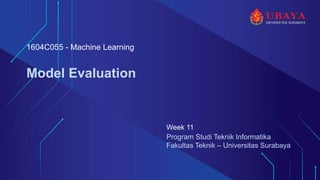
Week 11 Model Evalaution Model Evaluation
- 1. Program Studi Teknik Informatika Fakultas Teknik – Universitas Surabaya Model Evaluation Week 11 1604C055 - Machine Learning
- 2. Model Evaluation • Model evaluation is a process to measure the performance a classification model. • Aims to estimate the generalization performance of a model on future (unseen/new/out-of-sample) data. • Model evaluation is required to build a robust model.
- 3. How to evaluate the Classifier’s Generalization Performance? • Assume that we test a binary classifier on some test set, and we derive at the end the following confusion matrix: Predicted class Actual class Pos Neg Pos TP FN Neg FP TN P N
- 4. Metrics for Classifier’s Evaluation • Accuracy = 𝑇𝑃+𝑇𝑁 𝑃+𝑁 • Error = 𝐹𝑃+𝐹𝑁 𝑃+𝑁 = 1 − Accuracy • Precision = 𝑇𝑃 𝑇𝑃+𝐹𝑃 • Recall/ Sensitivity/TP rate = 𝑇𝑃 𝑃 • FP Rate = 𝐹𝑃 𝑁 • Specificity = 𝑇𝑁 𝑁 = 1– FP Rate • F1 score = 2 × 𝑃𝑟𝑒𝑐𝑖𝑠𝑖𝑜𝑛×𝑅𝑒𝑐𝑎𝑙𝑙 𝑃𝑟𝑒𝑐𝑖𝑠𝑖𝑜𝑛+𝑅𝑒𝑐𝑎𝑙𝑙
- 5. Metrics for Classifier’s Evaluation • For multiclass classification – Accuracy = #correctly classified objects #objects – Precision and recall for a certain class can be calculated by assuming that the class is positive class and the remaining classes are negative class
- 6. How to Estimate the Metrics? • We can use: – Training data; – Independent test data; – Hold-out method; – k-fold cross-validation method; – Leave-one-out method; – Bootstrap method; – And many more…
- 7. Estimation with Training Data • The accuracy/error estimates on the training data are not good indicators of performance on future data. – Q: Why? – A: Because new data will probably not be exactly the same as the training data! • The accuracy/error estimates on the training data measure the degree of classifier’s overfitting. Training set Classifier Training set
- 8. Estimation with Independent Test Data • Estimation with independent test data is used when we have plenty of data and there is a natural way to forming training and test data. • For example: Quinlan in 1987 reported experiments in a medical domain for which the classifiers were trained on data from 1985 and tested on data from 1986. Training set Classifier Test set
- 9. Hold-out Method • The hold-out method splits the data into training data and test data. (e.g., 60:40, 2/3:1/3, 70:30) • Then we build a classifier using the train data and test it using the test data. • The hold-out method is usually used when we have thousands of instances, including several hundred instances from each class. Training set Classifier Test set Data
- 10. Train, Validation, Test Split Data Predictions Y N Results Known Training set Validation set + + - - + Classifier Builder Evaluate + - + - Classifier Final Test Set + - + - Final Evaluation Model Builder The test data can’t be used for parameter tuning!
- 11. Making the Most of the Data • Once evaluation is complete, all the data can be used to build the final classifier. • Generally, the larger the training data the better the classifier (but returns diminish). • The larger the test data the more accurate the error estimate.
- 12. Stratification • The holdout method reserves a certain amount for testing and uses the remainder for training. – Example: one third for testing, the rest for training. • For “unbalanced” datasets, samples might not be representative. – Few or none instances of some classes. • Stratified sample: advanced version of balancing the data. – Make sure that each class is represented with approximately equal proportions in both subsets.
- 13. Repeated Holdout Method • Holdout estimate can be made more reliable by repeating the process with different subsamples. – In each iteration, a certain proportion is randomly selected for training (possibly with stratification). – The error rates on the different iterations are averaged to yield an overall error rate. • This is called the repeated holdout method.
- 14. Repeated Holdout Method • Still not optimum: the different test sets overlap, but we would like all our instances from the data to be tested at least ones. • Can we prevent overlapping? witten & eibe
- 15. k-Fold Cross-Validation • k-fold cross-validation avoids overlapping test sets: – First step: data is split into k subsets of equal size; – Second step: each subset in turn is used for testing and the remainder for training. • The subsets are stratified • before the cross-validation. • The estimates are averaged to • yield an overall estimate. Classifier Data train train test train test train test train train
- 16. More on Cross-Validation • Standard method for evaluation: stratified 10-fold cross-validation. • Why 10? Extensive experiments have shown that this is the best choice to get an accurate estimate. • Stratification reduces the estimate’s variance. • Even better: repeated stratified cross-validation: – E.g. ten-fold cross-validation is repeated ten times and results are averaged (reduces the variance).
- 17. Leave-One-Out Cross-Validation • Leave-One-Out is a particular form of cross-validation: – Set number of folds to number of training instances; – I.e., for n training instances, build classifier n times. • Makes best use of the data. • Involves no random sub-sampling. • Very computationally expensive. • A disadvantage of Leave-One-Out-CV is that stratification is not possible: – It guarantees a non-stratified sample because there is only one instance in the test set!
- 18. Model Evaluation in Python: Train Test Split
- 19. Model Evaluation in Python: Confusion Matrix
- 20. Model Evaluation in Python: Graphical Confusion Matrix
- 21. Model Evaluation in Python: Evaluation Metrics
- 22. Model Evaluation in Python: Train, Validation, Test Split
- 23. Model Evaluation in Python: Stratified Repeated Hold Out
- 24. Model Evaluation in Python: k-Fold Cross-Validation
- 25. Model Evaluation in Python: Leave-One-Out Cross-Validation